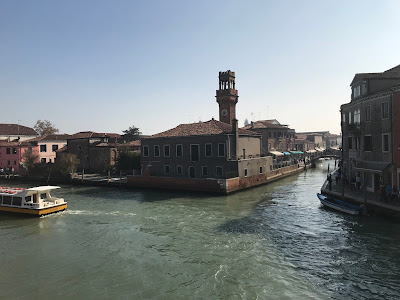Murano, like Venice, is a series of islands linked by bridges in the Venetian Lagoon, slightly less than a mile north of Venice. Of course the island is known primarily for its glass making. In 1291 Venice forced all of its famed glassmakers to relocate to remote Murano for fear of fire from their furnaces.
Unlike tourist ridden Venice Murano still feels real; one comes across scenes of laundry hanging out to dry and the school children running amok once school let out.
While dating back to Roman times the island was heavily built up in the 15th century by Venetians who treated the area as a resort. I suspect the building above may date from this time.
The picturesque canals are filled with modern motorboats unlike nearby Venice; these are active canals!
In the center of town is the clock tour.
The church of St Pietro Martire lies at this intersection as well and dates to 1511. Notice the enormous glass chandelier above. I admit I thought I'd see a lot more glass in use although the town is littered with glass shops catering to tourists.
As with any good Italian town there are many catholic churches -the charming facade above is the Oratorio Ex Ospizio Briati.
The most well known of the Murano churches is the Church of Santa Maria e San Donato. Dating to the 7th century, the later byzantine mosaic floors of the main chapel date to 1140.
These stunning floors were one of the best things we saw that day!
Ancient lost little corners are to be found throughout the island. I loved the sunlight pouring through this walled garden across the street from the church.
Palazzo dot the larger canals, much like Venice, although these are in more charmingly derelict condition. I highly recommend a visit to the glass museum located in one of these houses, the Palazzo Giustinian.
Other than exploring this grand palazzo the best part of the museum is the instructive video just off the lobby which shows all of the different glass blowing techniques.
The collection includes relics from Roman times up to current glass marvels such as this Venini glass vase from 1930.
This milk glass from the late 18th century mimics much more expensive bone porcelain which was new to Europe at the time.Next to the instructive video was this beautiful glass sculpture from the last decade: reminds me of a Picasso painting brought to life.
The details of this glass that is 100s of years old is really astounding.
Who doesn't need a huge assembled Murano glass rooster?
This large tabletop decoration or deseri created for the Doge in the 18th century was astoundingly detailed. I've always been obsessed with miniature recreations of houses and gardens.Would you believe the goblet above with delicate spiral base dates to 1895? It was created for the very first Venice biennale.
Exquisite artistry isn't all old though - this covered goblet above dates from the 1970s.
The making of the famous Murano beads also includes these miniature rolls, seen above. Tiny glass rods are melted together to create scenes in a log, which are then sliced into cameos for jewelry. Notice the tiny slice above with a gondola and another reading Angelina; That is smaller than a toenail clipping (but much less disgusting) and barely legible.
The easiest way to get to Murano from Venice is using the Vaporetto service - sort of like a public bus. I'm glad we purchased a week long pass as individual rides are around $7 euro each and we had a lot of fun hopping on and off of the boats exploring Venice and nearby islands without worrying about the cost of each trip. Between Murano and Burano are a number of slowly disappearing islands which are being eroded by heavy boat traffic. The history of the island above, the Madonna del Monte, is really interesting - you'll only be able to see it for another few years before it completely falls into the lagoon; read about it HERE.
Much like Paris, Venice is always a good idea. Avoid the big tourist areas around the middle of the day when the horrible cruise ships unload onto the tiny islands; a leisurely lunch will solve that. I went into the trip worrying if we would have enough to do to fill the week and left feeling we barely scratched the surface.
One last note about Murano: Glass shops are plentiful and for small (genuine) souvenirs I highly recommend the family run shop at 22 Riva Longa (the central main canal). The family business reaches back generations and the current proprietor is designer and shop keeper who is a lot of fun and so knowledgeable about the local glass!














































.jpg)





















.JPG)






































































